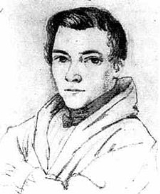
Karl Wilhelm Feuerbach
Encyclopedia
Karl Wilhelm von Feuerbach (30 May 1800 – 12 March 1834) was a German
geometer and the son of legal scholar Paul Johann Anselm Ritter von Feuerbach
, and the brother of philosopher Ludwig Feuerbach. After receiving his doctorate at age 22, he became a professor of mathematics
at the Gymnasium
at Erlangen
. In 1822 he wrote a small book on mathematics noted mainly for a theorem on the nine-point circle
, which is now known as Feuerbach's theorem. In 1827 he introduced homogeneous coordinates
, independently of Möbius
.
Germany
Germany , officially the Federal Republic of Germany , is a federal parliamentary republic in Europe. The country consists of 16 states while the capital and largest city is Berlin. Germany covers an area of 357,021 km2 and has a largely temperate seasonal climate...
geometer and the son of legal scholar Paul Johann Anselm Ritter von Feuerbach
Paul Johann Anselm Ritter von Feuerbach
Paul Johann Anselm Ritter von Feuerbach was a German legal scholar. His major work was a reform of the Bavarian penal code which became a model for several other countries.-Biography:...
, and the brother of philosopher Ludwig Feuerbach. After receiving his doctorate at age 22, he became a professor of mathematics
Mathematics
Mathematics is the study of quantity, space, structure, and change. Mathematicians seek out patterns and formulate new conjectures. Mathematicians resolve the truth or falsity of conjectures by mathematical proofs, which are arguments sufficient to convince other mathematicians of their validity...
at the Gymnasium
Gymnasium (school)
A gymnasium is a type of school providing secondary education in some parts of Europe, comparable to English grammar schools or sixth form colleges and U.S. college preparatory high schools. The word γυμνάσιον was used in Ancient Greece, meaning a locality for both physical and intellectual...
at Erlangen
Erlangen
Erlangen is a Middle Franconian city in Bavaria, Germany. It is located at the confluence of the river Regnitz and its large tributary, the Untere Schwabach.Erlangen has more than 100,000 inhabitants....
. In 1822 he wrote a small book on mathematics noted mainly for a theorem on the nine-point circle
Nine-point circle
In geometry, the nine-point circle is a circle that can be constructed for any given triangle. It is so named because it passes through nine significant points defined from the triangle...
, which is now known as Feuerbach's theorem. In 1827 he introduced homogeneous coordinates
Homogeneous coordinates
In mathematics, homogeneous coordinates, introduced by August Ferdinand Möbius in his 1827 work Der barycentrische Calcül, are a system of coordinates used in projective geometry much as Cartesian coordinates are used in Euclidean geometry. They have the advantage that the coordinates of points,...
, independently of Möbius
August Ferdinand Möbius
August Ferdinand Möbius was a German mathematician and theoretical astronomer.He is best known for his discovery of the Möbius strip, a non-orientable two-dimensional surface with only one side when embedded in three-dimensional Euclidean space. It was independently discovered by Johann Benedict...
.
Works
- Eigenschaften einiger merkwürdigen Punkte des geradlinigen Dreiecks und mehrerer durch sie bestimmten Linien und Figuren: Eine analytisch-trigonometrische Abhandlung ("Properties of some special points in the plane of a triangle, and various lines and figures determined by these points: an analytic-trigonometric treatment")
- Grundriss zu analytischen Untersuchungen der dreyeckigen Pyramide ("Foundations of the analytic theory of the triangular pyramid")

